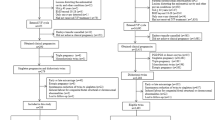Abstract
Purpose: To determine whether maternal age and number of transferred embryos influence early pregnancy losses in twin pregnancies compared to singletons following IVF/ICSI.
Methods: We compared the pregnancy loss rates in singleton (n = 549) and twin (n = 252) gestations, stratified by maternal age (≤35 and > 35 years) and the number of transferred embryos (1–3 and 4–9).
Results: Loss rates of singleton pregnancies were significantly higher than that in twins (OR 3.0, 95% CI 1.9, 4.9), especially among singletons conceived after transfer of 4–9 embryos (OR 5.0, 95% CI 2.2, 11.9). Younger mothers of twins had lower loss rates (OR 0.3, 95% CI 0.1, 0.9).
Conclusion: Twins have a significantly reduced spontaneous miscarriage rate compared with singletons following IVF/ICSI. Higher implantation rates per cycle (i.e., development of twins rather than one live embryo) may represent a better capacity of the uterus for early embryonic development.
Similar content being viewed by others
References
Dickey RP, Taylor SN, Lu PY, Sartor BM, Storment JM, Rye PH, Pelletier WD, Zender JL, Matulich EM: Spontaneous reduction of multiple pregnancy: Incidence and effect on outcome. Am J Obstet Gynecol 2002;186:77–83
Landy HJ, Keith LG: The vanishing twin: A review. Hum Reprod Update 1998;4:177–183
Tummers P, De Sutter P, Dhont M: Risk of spontaneous abortion in singleton and twin pregnancies after IVF/ICSI. Hum Reprod 2003;18:1720–1723
Zegers-Hochschild F, Bravo M, Fernandez E, Fabers C, Balmaceda JP, Mackenna A: Multiple gestation as a marker of reproductive efficacy: Learning from assisted reproductive technologies. Reprod Biomed Online 2003;8:125–129
La Sala GB, Nucera G, Gallinelli A, Nicoli A, Villani MT, Blickstein I: Spontaneous Embryonic loss following in vitro fertilization: incidence and effect on outcomes. Am J Obstet Gynecol 2004;191:741–746
Dickey RP, Olar TT, Curole DN, Taylor SN, Rye PH, Matulich EM: The probability of multiple births when multiple gestational sacs or viable embryos are diagnosed at first trimester ultrasound. Hum Reprod 1990;5:880–882
Balen AH, MacDougall J, Tan SL: The influence of the number of embryos transferred in 1060 in-vitro fertilization pregnancies on miscarriage rates and pregnancy outcome. Hum Reprod 1993;8:1324–1328
La Sala GB, Nucera G, Gallinelli A, Nicoli A, Villani MT, Blickstein I: Spontaneous Embryonic loss following in vitro fertilization with and without intracytoplasmic sperm injection. Fertil Steril 2004;82:1536–1539
Schieve LA, Tatham L, Peterson HB, Toner J, Jeng G: Spontaneous abortion among pregnancies conceived using assisted reproductive technology in the United States. Obstet Gynecol 2003;101:959–967
Carmona F, Balasch J, Creus M, Fabregues F, Casamitjana R, Civico S, Vidal E, Calafell JM, Moreno V, Vanrell JA: Early hormonal markers of pregnancy outcome after in vitro fertilization and embryo transfer. J Assist Reprod Genet 2003;20:521–526
Long CA, Lincoln SR, Whitworth NS, Cowan BD: Progesterone concentration as a predictor of pregnancy normalcy is the most useful when hCG levels are less than 2000 mIU/mL. J Assist Reprod Genet 1995;12:195–197
Urbancsek J, Hauzman E, Fedorcsak P, Halmos A, Devenyi N, Papp Z: Serum human chorionic gonadotropin measurements may predict pregnancy outcome and multiple gestation after in vitro fertilization. Fertil Steril 2002;78:540–542
Author information
Authors and Affiliations
Corresponding author
Rights and permissions
About this article
Cite this article
Sala, G.B.L., Nucera, G., Gallinelli, A. et al. Lower embryonic loss rates among twin gestations following assisted reproduction. J Assist Reprod Genet 22, 181–184 (2005). https://doi.org/10.1007/s10815-005-4919-1
Received:
Accepted:
Issue Date:
DOI: https://doi.org/10.1007/s10815-005-4919-1




